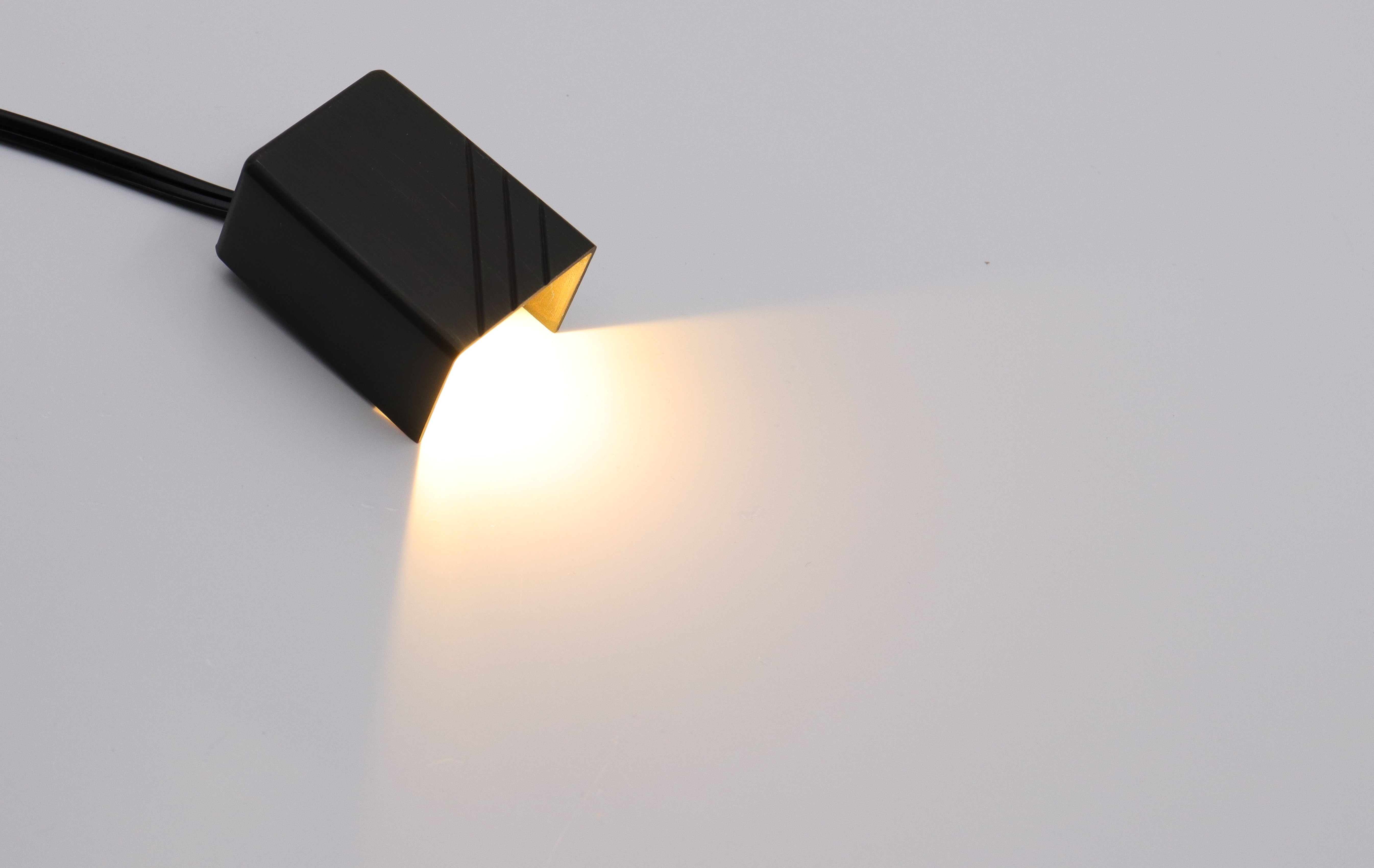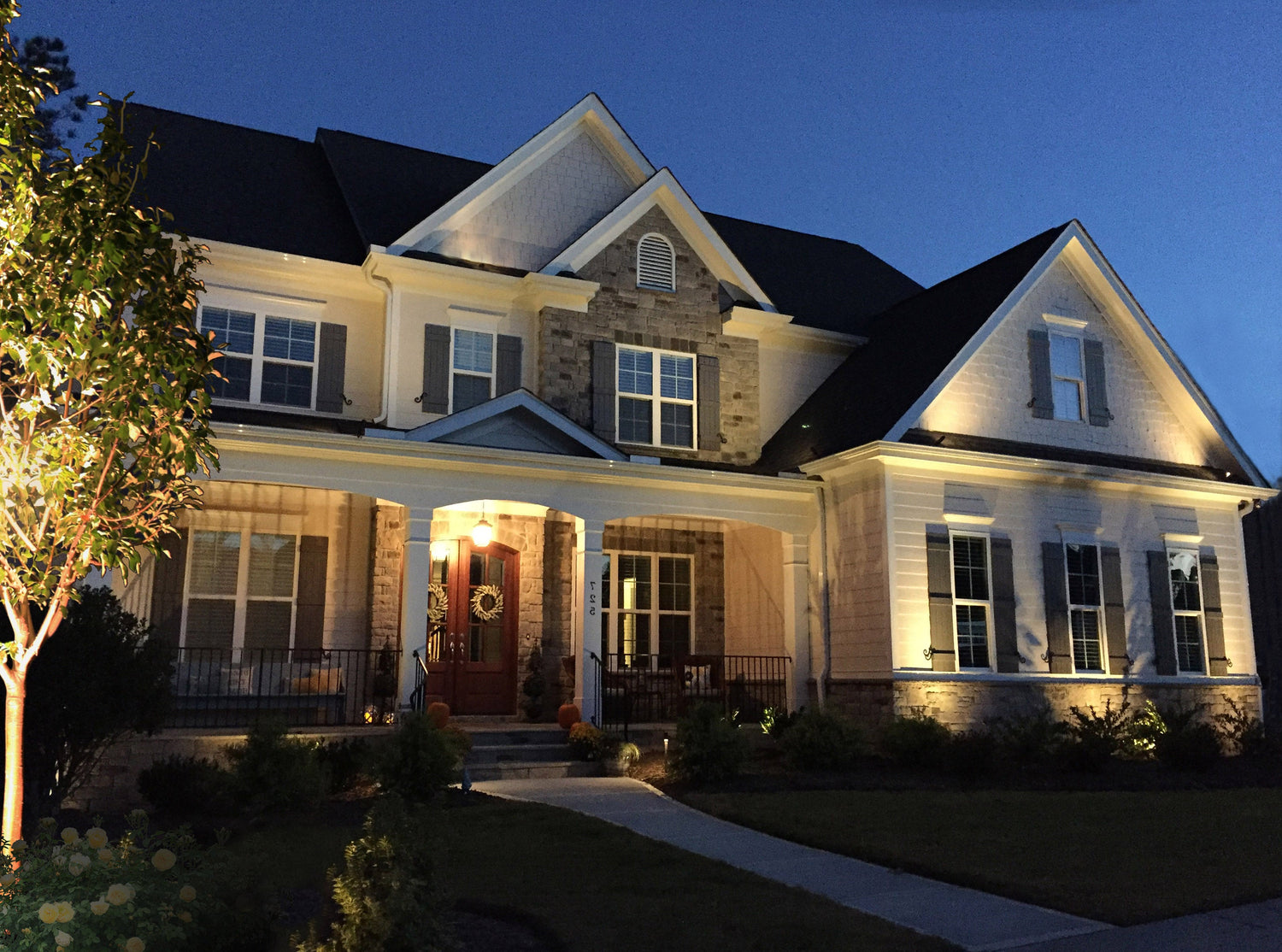| Aspect | Soffit Lighting | Uplighting |
|---|---|---|
| Aesthetic Appeal | Provides flat, plain illumination. | Highlights architectural details, enhances curb appeal. |
| Flexibility in Placement | Limited to eaves and overhangs. | Can be placed creatively anywhere, including trees and base of columns. |
| Security Enhancement | Offers generic illumination. | Eliminates dark spots, improves visibility with targeted light. |
| Artistic and Dramatic Effects | Limited in creating dramatic effects. | Offers limitless artistic possibilities and dramatic effects. |
| Ambiance and Curb Appeal | Creates a cold, industrial look. | Provides a warm, inviting glow and enhances curb appeal. |
| Energy Efficiency and Cost-Effectiveness | Less energy-efficient, higher maintenance costs. | More energy-efficient, cost-effective in the long run. |
| Minimization of Light Pollution | Often creates glare and light pollution. | Minimizes glare and pollution with precise light control. |
| Durability and Maintenance | Requires frequent bulb changes and maintenance. | Long-lasting LED technology with minimal maintenance. |
| Landscape Feature Enhancement | Cannot spotlight landscape features. | Can spotlight and enhance landscape elements. |
| Quality of Illumination | Direct glare, harsh shadows. | Soft, diffuse glow, excellent color rendering. |
| Architectural Complement | Non-directional, fails to highlight architectural styles. | Enhances any architectural style with tailored lighting. |
| Creative Design Possibilities | Minimal flexibility beyond basic illumination. | Unlimited creative potential for custom lighting designs. |
| Initial Installation Cost | Lower upfront costs. | Higher initial costs but more benefits in the long term. |
When designing an exterior lighting plan for a home, two common options are soffit lighting and uplighting. At first glance, simple fluorescent soffit fixtures may seem like the default and most affordable choice. However, uplighting offers significant advantages in both aesthetics and functionality. Here are the key reasons why uplighting is a better alternative to soffit lighting for exterior home illumination:
Accents Architecture for Curb Appeal
Uplighting allows homeowners to artistically spotlight and accentuate architectural details that make their homes unique. For example, properly positioned uplights aimed at a peaked roofline will dramatize the sharp angles and draw the eye upward, showcasing striking curb appeal. Uplights can also graze across the ornamental trim and moldings around windows and doors, highlighting fine decorative details. Strategically placed uplights beaming upward along textured facades emphasize the visual depth and interest of the wall surfaces. Columns become elegant design features when lit from below by uplighting. Almost any exterior architectural element can be transformed and enhanced with targeted uplighting. This creative illumination attracts attention and transforms a home's curb appeal after dark. In contrast, soffit downlighting tends to provide only flat, plain illumination under eaves without any ability to selectively accent architecture.
Provides Flexible Placement Possibilities
One of the key advantages of uplighting is the flexibility it provides in positioning and aiming light fixtures. For example, compact LED uplights can be discreetly installed high up in branches of landscape trees and aimed at the home facade. The entire front wall becomes beautifully illuminated from the dramatic grazing light from above. Uplights can also be placed at the base of columns and aimed upward to showcase imposing column details. Perimeter uplighting allows walls to be lit by grazing light along their entire length. And staircases become elegant architectural features highlighted by amiable uplighting. There are virtually unlimited possibilities for accent lighting with creative aiming and positioning of uplights. By another side, contrast, soffit downlighting is rigidly limited to only illuminating the underside space below overhangs and eaves. Uplighting offers much more versatility.

Enhances Security Around the Perimeter
Strategically placed uplighting eliminates dark recesses around a home at night where intruders could potentially hide unseen. Illuminating with uplighting from below removes blind spots and shadows from alcoves, planting beds, stairwells, and other areas where a criminal could lurk. Uplighting also enables clearer visibility of movement and activity outside the home after dark. Light can be directed exactly where needed for optimal visibility without broadly lighting unnecessary areas. And motion-activated uplighting provides dynamic security illumination when needed. The strategic directional lighting of uplighting maximizes exterior home security compared to the generic illumination of soffit lighting.
Provides Artistic and Dramatic Lighting Effects
Uplighting affords designers almost limitless options for creating any desired artistic lighting mood or accent effect. For example, grazing a heavily textured stucco wall with side-projected uplighting emphasizes intriguing patterns and relief that are hidden by day. Brick or stone surfaces come alive with texture when lit from the side by uplighting. Columns are transformed into dramatic design elements by aiming uplights upward from concealed positions. Front entries and walkways guide guests with artistic pools of light from ground-recessed uplighting. Valuable garden sculptures or architectural details draw the eye when highlighted against darker backgrounds by uplighting. Almost any artistic exterior lighting effect can be achieved by thoughtfully positioning and angling uplights. For a detailed guide on various landscape lighting techniques that can further enhance your home's exterior, be sure to check out these 8 landscape lighting techniques.Soffit lighting is inherently limited for dramatic artistic effects.
Inviting Ambiance and Curb Appeal
Carefully designed uplighting creates a warm, welcoming glow along the exterior of a home to highlight curb appeal. Subtle uplighting aimed upward at trees or along pathways guides visitors with a soft ambient light. Accent uplighting on architectural details provides a sense of quality craftsmanship. Uplighting focused on address markers or house numbers helps identify the home. The overall result is an exterior ambiance after dark that feels inviting, artistic, and unique. This makes an impression on guests, neighborhood onlookers, and potential home buyers. In contrast, utilitarian fluorescent soffit lighting tends to create a cold, industrial look rather than welcoming curb appeal. For maximum ambiance, entrust uplighting design to an expert who can artfully blend light textures, colors, and intensities.
Energy-Efficient and Cost-Effective
Compared to traditional fluorescent soffit fixtures, today's LED uplighting systems consume far less electricity. The newest generation of LEDs can provide the same brightness as older lights at a fraction of the energy use. Unlike broad soffit lighting, uplighting focuses light only where needed, avoiding waste. Proper aiming and baffles further optimize efficiency. Fewer uplight fixtures are required compared to continuous rows of soffit lights. This combination of lower energy use per fixture and fewer total fixtures means LED uplighting is a more energy-efficient and cost-effective solution in the long run. Despite higher upfront costs, uplighting saves money over time with lower utility bills and dramatically less maintenance compared to soffit lights.

Minimizes Light Pollution and Glare
Good uplighting design minimizes glare, light spills, and light pollution. Full cut-off fixtures, baffles, and precision aiming direct the light precisely where needed, rather than allowing scatter upward or outward. Warm color temperature LEDs reduce glare versus harsh fluorescent lighting. Uplighting can also be dimmed or even switched off when not needed. Motion sensors selectively activate uplighting when visitors approach. In contrast, unshielded soffit fluorescent lights often create intense glare and light pollution. They directly illuminate outward and upward. Uplighting's directional precision controls light only where desired, avoiding nuisance spill and glare. This makes it a better environmental choice.
Longer Lifespan and Lower Maintenance
Today's LED and solid-state uplighting systems are designed to last for decades without replacement when properly installed. Compare this to fluorescent soffit lights, which require frequent bulb changes as they burn out every 1-2 years on average. Those periodic relamping costs add up, making soffit lighting higher in lifetime maintenance costs despite the lower upfront expense. Routine soffit light repairs like ballast and socket changes also add up over time. Since LED uplighting basically consists of fixtures and wiring with no bulbs, reliability is excellent, and maintenance costs are negligible. Uplighting remains a bright, energy-efficient solution with minimal upkeep year after year. The overall cost of ownership is lower compared to maintenance-intensive soffit lighting.
Showcases Landscape Features
Artistic uplighting at night can transform gardens and landscaping into a spotlighted showcase.
For example, gently grazing ornamental tree canopies with uplighting adds depth and drama, highlighting nature's artwork. Flowering shrubs become colorful focal points when illuminated by low-voltage fixtures hidden discretely in mulch beds. Lush groundcover plantings and rows of hedges guide visitors along pathways when illuminated by uplighting.
Strategic uplighting can also spotlight and accentuate specimen plants, textural plant materials, blossoming flowers, and more. Almost any element of the landscape design can be highlighted and enhanced with the wise use of uplighting aimed upward from concealed positions. Soffit lighting offers no ability to selectively spotlight prized horticultural elements after dark.
Better Illumination
The soft, diffuse glow of uplighting flatters home exteriors much better than the direct glare from bare soffit lights. Uplighting minimizes harsh shadows behind landscaping and under eaves compared to unshielded overhead lighting. Warm-toned LED uplighting provides excellent color rendering on building materials and plantings. Glare is eliminated by correct fixture selection, aiming angle, and light source shielding. The result is a welcoming exterior ambiance free of eye-straining glare spots. Soffit fluorescent lighting often appears uninvitingly industrial, with excessive contrasts between bright and dark areas. The smooth, flattering light of uplighting is inherently higher quality.
Compliments Architectural Style and Details
Uplighting allows homes of any architectural style to shine. For example, Craftsman bungalows come alive under uplighting that accentuates cascading roof lines, exposed rafters, and rustic stonework with texture-revealing light. Stately Colonial homes benefit from uplighting on symmetrical details like dormers, gables, columns, and entry pediments. Soft uplighting transforms Tudor revival exteriors by highlighting charmingly intricate trim, arched entryways, and stucco relief. No matter the style, discreetly positioned uplighting grazes surfaces to emphasize appealing architectural textures, angles, and shapes after dark. Non-directional soffit lighting fails to provide these custom accenting effects tailored to the home's aesthetics.
Allows Creative Lighting Design Concepts
Compared to boringly uniform soffit lighting, uplighting offers unlimited creative potential. Lighting experts can develop custom uplighting schemes tailored to clients' homes and preferences. For example, accent colors like amber or blue can be introduced with cleverly aimed uplighting. Dimmers allow adjustable mood settings from romantic to lively. Homeowners can even enjoy seasonal exterior lighting designs for holidays. Uplighting allows for any concept that showcases architecture, landscape features, unity of design, artwork, and home personality. There are no limits on the effects possible for custom uplighting plans. Soffit lighting offers minimal flexibility beyond basic illumination directly under eaves.
Lower Initial Installation Cost
It's true that basic fluorescent soffit fixtures carry lower upfront costs compared to professionally designed and installed LED uplighting systems. But over years of use, that soffit lighting accrues major hidden expenditures for frequent lamp/ballast replacements, higher energy bills, compromised security due to glare, and unaesthetic flat illumination. Professionally engineered uplighting avoids all those long-term drawbacks despite higher initial purchase costs. And increased home resale value from uplighting's curb appeal can return the investment. Viewed in terms of the total cost of ownership over decades, attractive and versatile LED uplighting emerges as the smarter investment compared to the false economy of bare soffit lighting.
In summary, uplighting clearly outperforms utilitarian soffit lighting for exterior home illumination. The artistic, inviting glow of uplighting showcases architecture, adds depth at night, enhances landscaping, deters crime, and boosts curb appeal. For most homes, a well-designed uplighting plan is the superior lighting choice for aesthetics and function. Just be sure to work with an experienced professional designer to get the best illumination design possible.







Leave a comment
All comments are moderated before being published.
This site is protected by hCaptcha and the hCaptcha Privacy Policy and Terms of Service apply.